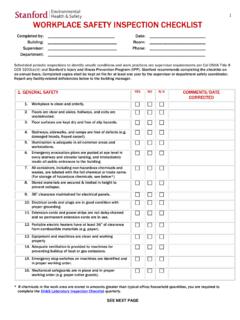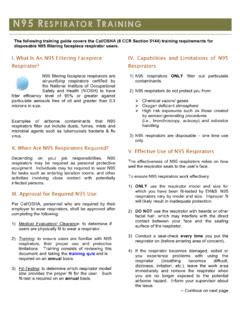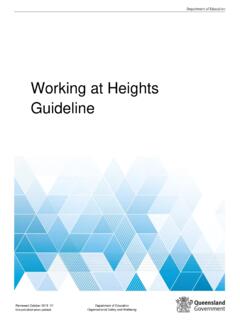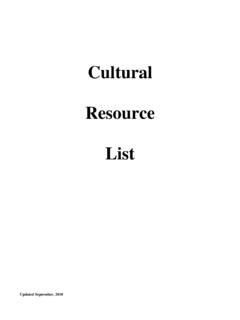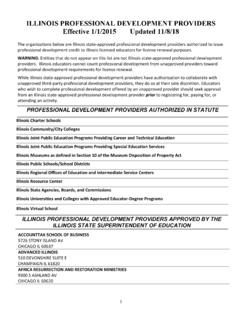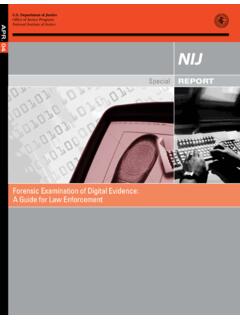Transcription of Laboratory Risk Assessment Tool - Stanford University
1 1 LSP_17-109-v2021 Last update: 12/06/2021 Laboratory Risk Assessment Tool The Stanford Laboratory Risk Assessment Tool provides a framework for risk Assessment that maps onto the scientific method, melding with the process researchers already use to answer scientific questions. This tool allows researchers to systematically identify and control hazards to reduce risk of injuries and incidents. Conduct a risk Assessment prior to conducting an experiment for the first time. The risk Assessment process involves rating the risk of the experiment, from low to unacceptable risk. Consult with your PI/supervisor and EH&S if your risk rating is high or unacceptable to redesign the experiment and/or implement additional controls to reduce risk. Procedure: Lab Group: Completed By: Date: Identify your research question and approach.
2 What question are you trying to answer? What are you trying to measure or learn? What is your hypothesis? What approach or method will you use to answer your question? Are there alternative approaches? Research Question(s) Approach(s) or Method EXPLORE 2 LSP_17-109-v2021 Last update: 12/06/2021 Identify the general hazards (check all that apply). Perform background research to identify known risks of the reagents, reactions, or processes. Review protocols, Safety Data Sheets (SDSs), and safety information for hazardous chemicals, agents, or processes. Review accident histories within your Laboratory /department and Lessons Learned at Stanford or other institutions. Hazardous Agents Physical Hazards of Chemicals Compressed gases Cryogens Explosives Flammables Organic peroxides Oxidizers Peroxide formers Pyrophorics Self-heating substances Self-reactive substances Substances which, in contact with water, emit flammable gases Health Hazards of Chemicals Acute toxicity Carcinogens Eye damage/irritation Germ cell mutagens Nanomaterials Reproductive toxins Respiratory or skin sensitization Simple asphyxiant Skin corrosion/irritation Specific target organ toxicity Hazards not otherwise classified Ionizing Radiation Irradiator Radionuclide Radionuclide sealed source X- ray machine Non-Ionizing Radiation Lasers, Class 3 or 4 Lasers.
3 Class 2 Magnetic fields ( , NMR, MRI) RF/microwaves UV lamps Biohazards BSL-2 Biological agents BSL-3 Biological agents Human cells, blood, BBP NHPs/cells/blood Non-exempt rDNA Animal field work High risk animals (RC1) Other (list): Hazardous Conditions or Processes Reaction Hazards Explosive Exothermic, with potential for fire, excessive heat, or runaway reaction Endothermic, with potential for freezing solvents decreased solubility or heterogeneous mixtures Gases produced Hazardous reaction intermediates/products Hazardous side reactions Hazardous Processes Generation of air contaminants (gases, aerosols, or particulates) Heating chemicals Large mass or volume Pressure > atmospheric Pressure < atmospheric Scale-up of reaction Other Hazards Hand/power tools Moving equipment/parts Electrical Noise > 80 dBA Heat/hot surfaces Ergonomic hazards Needles/sharps Other (list).
4 General Hazards Equipment Hazards Unguarded moving parts Cranes/lifts/hoists Ladders Energized equipment De-energized equipment High voltage (>50 volts) DC equipment (>800 Amperes) Maintenance/Modification of electrical equipment Robotics Home-built equipment Soldering Lithium batteries Pressure or vacuum vessels Ergonomic Hazards Repetitive motion Contact stress Cold environment Awkward postures Lifting >30 pounds Awkward lifts ( , poor grip, long distance, uneven weight distribution) Vibration Personal risk factors Strenuous physical activity Site Hazards Confined spaces Slippery surfaces working at elevated locations Oxygen deficiency potential Slip/trip/fall Other Hazards Mental demands ( , long days, high stress environment, language barriers) Lack of experience Other (list): 3 LSP_17-109-v2021 Last update: 12/06/2021 Outline the Procedure.
5 List the steps or tasks for your procedure and the hazard/potential consequences of each. Include set-up and clean-up steps or tasks. Define the hazard controls to minimize the risk of each step using the hierarchy of controls starting with the most effective ( , elimination, substitution, engineering controls, administrative controls, and personal protective equipment). List the hazard control measure you would use for each step or task ( , run at a micro scale, work in a fume hood, wear face shield and goggles). A hierarchy of controls should be applied starting with the most effective controls ( , elimination and substitution) at the top of the graphic and moving down. While personal protective equipment (PPE) should always be used, it should be considered the last line of defense from potential hazards.
6 1 For guidance on selection of Personal Protective Equipment (PPE), use Stanford s Laboratory PPE Assessment Tool. 2 For guidance on selection of chemical-resistant gloves, see Stanford s Laboratory Chemical Glove Selection Guide. Field Hazards *may also use sections above (as needed) for specific tasks/processes Environmental Hazards Inclement weather Temperature extremes Sun exposure Darkness/low light Altitude Smoke/dust Fire Animals/insects Plants/allergens Hygiene/water-borne and food-borne illness Vector-borne or other endemic diseases (list): Site Hazards Uneven/slippery surfaces Snow/ice Slide Hazards (mudslide/avalanche) Heights/drop-offs Falling objects Tight spaces/overhangs Boating/swimming/water hazards (waves, tides, current, depth) Navigation challenges Limited communication Remote area/limited medical services Personal Security Crime/theft Risk of harassment/violence US State Department active travel alert Traveling alone Entering personal residences Unfamiliar with area (roads, neighborhoods, terrain, etc.)
7 Unfamiliar with local customs/cultural norms Task/Equipment Hazards Driving/vehicle operation/traffic Drone use Lifting/carrying Digging/trenching Hand tools/power tools Sharp objects Loud noises Strenuous physical activity Mental demands ( , long days, high stress environment, language barriers) Other (list): PLAN 4 LSP_17-109-v2021 Last update: 12/06/2021 Outline the Procedure. Steps or Tasks Hazard Hazard Control Measure(s) PLAN 5 LSP_17-109-v2021 Last update: 12/06/2021 Select the appropriate PPE and safety supplies for the procedure (check all that apply). Laboratory PPE/Safety Supplies Appropriate street clothing (long pants, closed-toed shoes) Gloves; indicate type: _____ Safety glasses Safety goggles Face shield and googles Lab coat Flame-resistant lab coat Other (list): Fire extinguisher Eyewash/safety shower First aid kit Spill kit Specialized medical supplies ( , calcium gluconate for hydrofluoric acid) General Safety Supplies Proper clothing (long pants, long sleeve shirt, warm layers, rain/wind protection, sun protection, hat etc.)
8 Proper footwear (list): _____ Communication device Eye protection (safety glasses and/or sunglasses) Work gloves Hardhat Hearing protection First aid kit Map (and GPS) Sunscreen Anti-animal devices ( , bear bell, whistle, bear canister) Personal floatation device Fall protection Road flares Safety vests Extra food, water/water treatment method Personal medications Other (list all): Identify the appropriate training (check all that apply). Identify the general safety and procedure based/specific training appropriate for your procedure. General Safety General Safety General Safety & Emergency Preparedness (EHS-4200) Laboratory Ergonomics (EHS-4800) Confined Space Entry or Awareness (EHS-2300 or EHS-2450) Electrical Safety Awareness (EHS-2800) Fire Extinguisher Use in Labs (EHS-3825) Chemical Safety Chemical Safety for Laboratories (EHS-1900) Compressed Gas Safety (EHS-2200) Cryogenic Liquids and Dry Ice Safety (EHS-2480).
9 Radiation Safety Radiation Safety and Radiation Safety Hands-On (EHS-5250 and 5251) Radiation Safety SAIF (Small Animal Imaging Facility) (EHS-5255) Sealed Sources, Non-Irradiator (EHS-5265) Research Cabinet X-ray or Irradiator (EHS-1755) and Refresher (EHS-1756) Irradiator Security Training (EHS-4780) and Refresher (EHS-4781) Laser Safety (EHS-4820) and Refresher (EHS- 4821) Biosafety Biosafety (EHS-1500) Bloodborne Pathogens (EHS-1600) and Refresher (EHS-1601) Field Safety CPR Wilderness First Aid SCUBA certification/diving safety Driving safety Other (list): Procedure Based/Job Specific Training Lab/job-specific training Lab SOP(s) to review (list): Emergency plans or field evacuation plans Equipment SOP(s) to review (list): Other (list): 6 LSP_17-109-v2021 Last update: 12/06/2021 Question your methods.
10 What have you missed and who can advise you? Challenge your hazard control measures by asking What questions. What if questions should challenge you to find the gaps in your knowledge or logic. Factors to consider are human error, equipment failures, and deviations from the planned/expected parameters ( , temperature, pressure, time, flow rate, and scale/concentration). Assign a risk rating to the experiment. Based on your procedure outline and the what if analysis, determine the risk rating for the experiment or procedure. Risk Rating: ___ _____ Revise plan if the risk rating is too high. Are these risks acceptable? Use the table below to determine the action to take based on the risk rating. What are the highest risk steps? What more can you do to control the risks?

